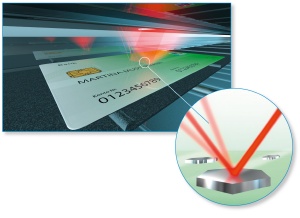Jun 15 2009
In 2008, debit card fraud with counterfeit cards caused losses of around EUR 40 million in Germany. Now, the new polycarbonate film Makrofol® ID ProteXXion from Bayer MaterialScience AG could put a stop to this kind of fraud once and for all.
 Upon inserting the ATM card in the machine, the laser light of the reader precisely scans the surface. The laser beam strikes the film at an obtuse angle and detects the tiny metal platelets.
Upon inserting the ATM card in the machine, the laser light of the reader precisely scans the surface. The laser beam strikes the film at an obtuse angle and detects the tiny metal platelets.
The film contains tiny metallic identification particles (OVDot®), which are distributed stochastically and can be arranged in customized patterns to deliver identification security features. This overlay film can be used to give polycarbonate security documents, such as IDs, passports, drivers’ licenses and, in the future, also credit cards, an unmistakable, unique surface. It also holds excellent potential for protecting high-quality branded articles and in the production of counterfeit-proof labels. “Thanks to the random distribution of the metal particles, every ID made of our new film is unique and, therefore, virtually counterfeit-proof,” says Cengiz Yesildag, Head of Sales in the Films Unit at Bayer MaterialScience.
The metal particles, which measure around a tenth of a millimeter, can also be provided with alphanumeric information, such as letters, to meet specific customer requirements. Logos, pictograms and national emblems can also be incorporated. “This adds an extra dimension to the card security,” explains Dirk Pophusen, Head of Business Development in the Films Unit at Bayer MaterialScience.
The new film is available in a standard thickness of 100 micrometers. It can be formed when either hot or cold and back-injected with thermoplastics in a process known as Film Insert Molding (FIM). It can be decorated beforehand using screen printing or laser engraving.
The Films Unit is working closely with Bayer Technology Services GmbH on the market launch of the new film. The cooperation came about as a result of the ProteXXion® technology platform recently launched by the Bayer subgroup. This platform features laser-optic scanners for reading off surface information to ensure counterfeit-proof authentication of objects. The light beam of a laser scanner records and digitizes the reflective characteristics of an object’s surface and compresses the information using special analysis algorithms. The resulting datasets can be compared at any time with previously generated registration scans stored in a database – either locally or via a Web application. This enables the object or card to be unambiguously authenticated. “Customers using cards made of our new film have access to all the technical peripherals of ProteXXion® – such as laser-optic scanners and analysis and comparison software – for quick and unambiguous card identification,” explains Dr. Markus Gerigk, Head of Authentification Solutions at Bayer Technology Services.